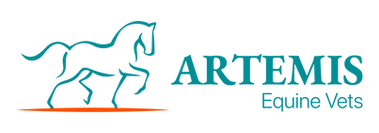Poor Performance Investigation
A decline or change in a horse’s usual performance can result from a wide range of underlying issues. At Artemis Equine Vets, we are committed to identifying the root causes of poor performance and supporting owners in returning their horses to optimal athletic function.
Poor performance may stem from various factors, including subtle or low grade lameness, back or neck pain, viral or systemic illness, gastric ulceration, respiratory conditions such as equine asthma, reproductive or dental problems, cardiac issues, tack or bitting discomfort, or simply the horse reaching or exceeding its natural athletic limits. When assessing performance concerns, especially those only apparent under saddle, it is ideal for the horse to be ridden in its usual tack by its regular rider.

Veterinary investigation typically includes both orthopaedic and medical assessments. These may involve a static examination, palpation, trot-up, lunge evaluation, and ridden assessment. Additional diagnostics such as blood profiling or procedures like gastroscopy may be recommended based on clinical findings. A range of diagnostic imaging techniques may be employed, including radiography, ultrasonography, diagnostic analgesia, thermography, endoscopy, and gastroscopy.
Some investigations may require multiple visits or an extended stay at the clinic, particularly when procedures like gastroscopy necessitate overnight fasting.
Our purpose built facilities include stocks, a dedicated treatment area, and high quality trot-up, lunge, and ridden surfaces - enabling us to carry out comprehensive evaluations to the highest standard.
We maintain strong collaborative relationships with leading referral hospitals offering advanced imaging options such as MRI, CT, nuclear scintigraphy, and surgical intervention when required.
To ensure a holistic approach, we also work closely with farriers, physiotherapists, and other equine professionals, delivering integrated care designed to maximise each horse’s potential for a successful return to performance.

